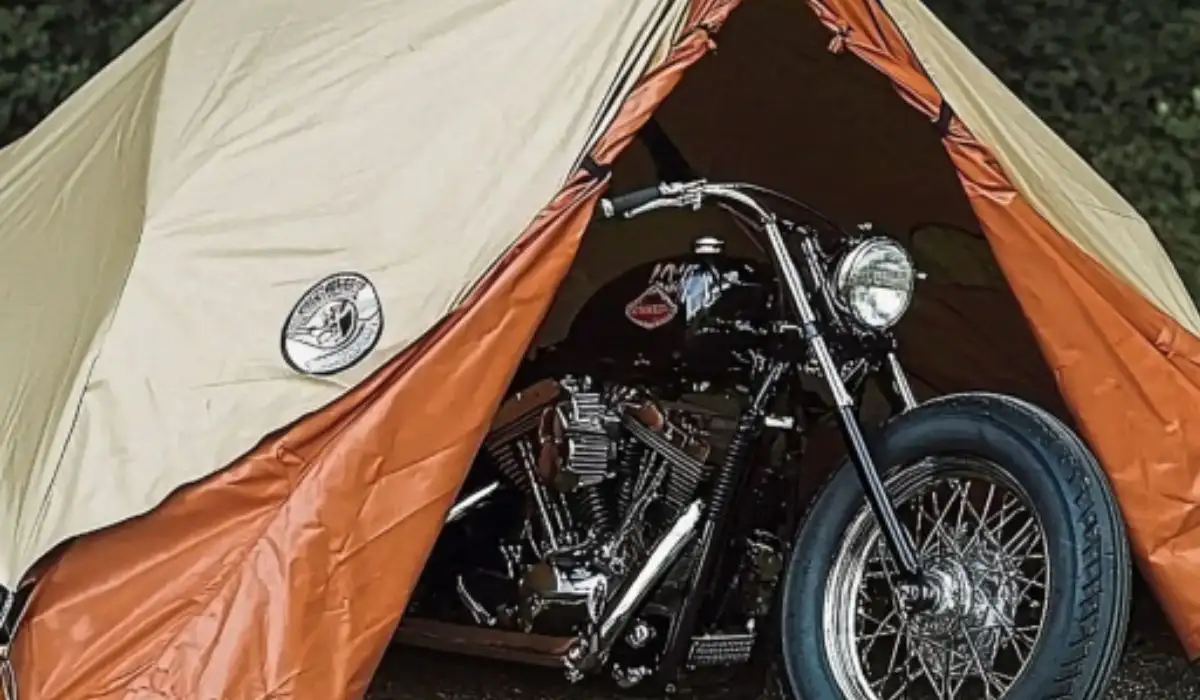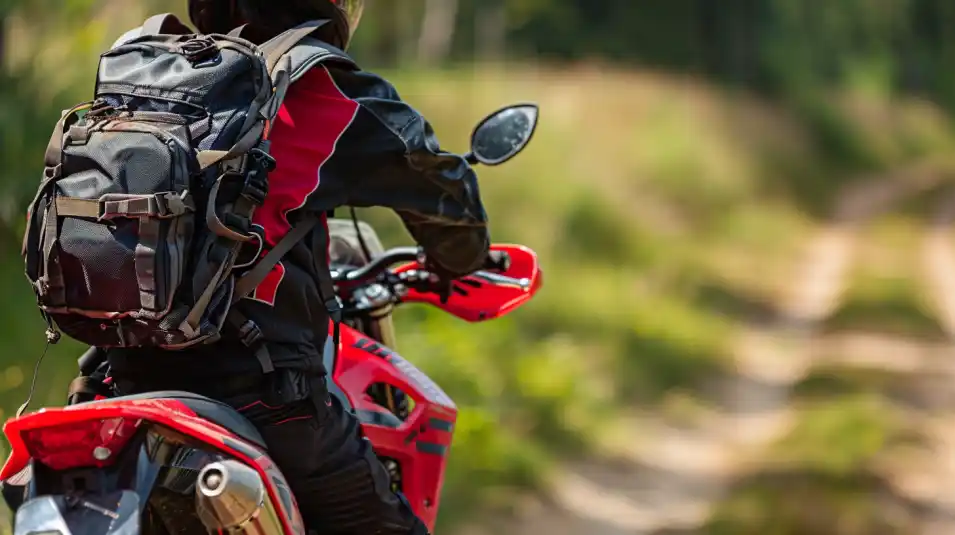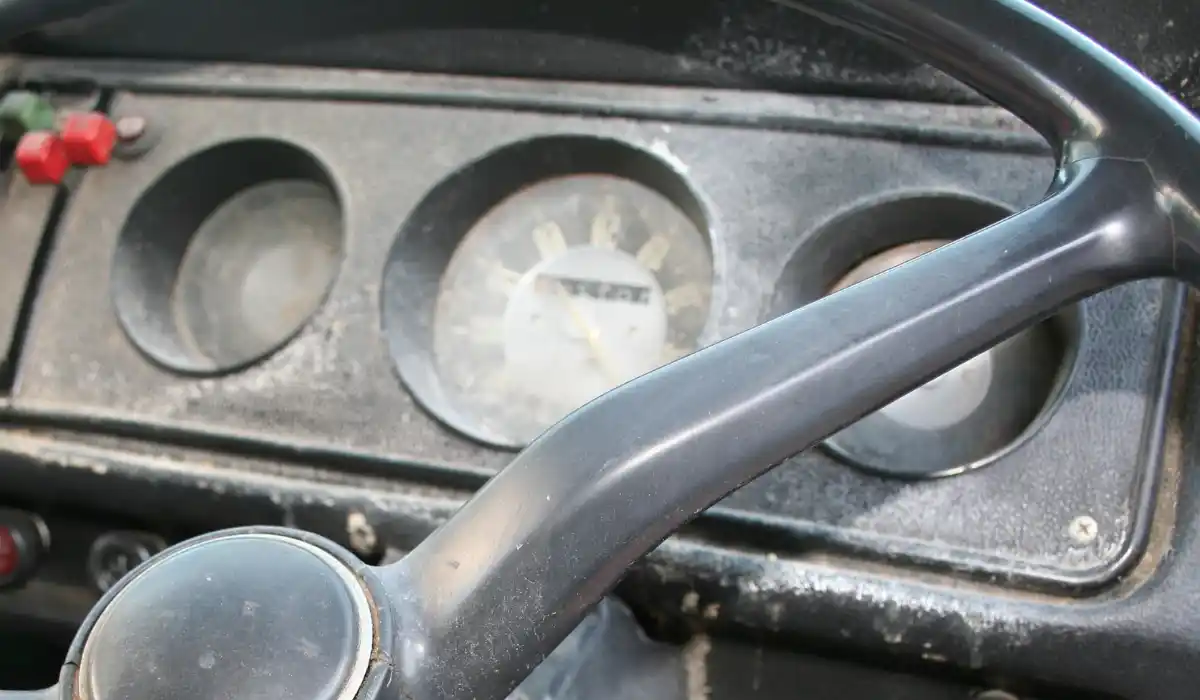Hitting the open road and exploring new places is what riding a motorcycle is all about. Nothing compares to the freedom your bike gives you with the fresh air and beautiful scenery around you.
What if you want to share these memories and the beautiful sights you see with your friends and family? That’s where having the best motorcycle helmet camera comes in.
When it comes to these helmet cams, how do you know which one is going to provide you with the footage you want? Well, that’s why I put this post together to help you find the best motorcycle camera to use on your rides.
So instead of stopping every time you want to capture something, you can start capturing videos and photos while you’re riding. In this post we’ll look at some great cameras as well as a buyer’s guide to help you make the most informed decision.
Let’s jump right into it!
Jump Ahead To:
The Best Motorcycle Helmet Camera

Our Top Recommendations
If you’re in a hurry, here are my top recommendations for the best motorcycle helmet cameras:
Runners Up:
- DJI Osmo Action 3 – Best Value
- GoPro HERO11 Black Mini – Most Compact
- AKASO EK7000 Pro – Best Budget 1080p
Now let’s dive into the full reviews!
Best Helmet Cameras in 2024
Insta360 ONE RS Twin
Key Features:
- Interchangeable lens modules
- Shoots up to 5.7K video
- Advanced image stabilization
- Rugged, waterproof design
What we like
- Total versatility with interchangeable modules
- Exceptional image quality
- Tons of mounting options
- Great companion app
What we don’t like
- Pricey
- Can be tricky to change modules with gloves on
The Insta360 ONE RS Twin is my choice for the best overall motorcycle helmet camera. This innovative, modular action cam allows you to swap between 4K and 360-degree modules to get the perfect shot.
With its unique modular design, the ONE RS Twin stands in a class of its own for versatility. You can swap lenses to go from immersive 360 capturing to pin-sharp 5.7K footage. This gives you unparalleled flexibility to nail the perfect shot.
The interchangeable battery design also means you can hot swap batteries on the go for unlimited runtime.
All of this combines with pro-grade stabilization and stellar companion apps for mobile editing and sharing.
Yes, it demands a premium price, but for riders who want limitless creative potential, the ONE RS Twin is the clear choice.
GoPro HERO11 Black
Key Features:
- 5.3K/60fps, 4K/120fps video
- 27MP photo resolution
- HyperSmooth 5.0 stabilization
- Rugged, waterproof design
What we like
- Best-in-class image quality
- Rich accessory ecosystem
- Intuitive touch controls
- Excellent stabilization
What we don’t like
- Very expensive
- Mediocre battery life
If you want the absolute best image quality, the new GoPro HERO11 Black takes the crown. With its large new sensor, it captures incredibly sharp 5.3K video and 27MP photos.
Simply put, the image quality from the HERO11 Black is on another level. The large new sensor captures beautiful cinematic shots with tons of detail and shockingly good low light performance. You can clearly see the improvement over past GoPro models.
This pairs with their most advanced HyperSmooth stabilization ever for outrageously smooth footage across all modes.
The tried and true waterproof design withstands any riding conditions. While the battery life leaves something to be desired, the HERO11 Black is the undisputed choice for riders prioritizing sheer imaging excellence.
DJI Osmo Action 3
Key Features:
- 4K/120fps, 2.7K/240fps video
- 12MP photos
- Front color screen
- RockSteady 3.0 stabilization
What we like
- Great value for money
- Excellent image quality
- Intuitive touch controls
- Robust stabilization
What we don’t like
- Not as many mounting options as GoPro
- Mediocre battery life
The DJI Osmo Action 3 packs impressive specs like 4K/120fps video into a compact form factor at a very appealing price point.
Pound for pound, the Osmo Action 3 gives you the most bang for your buck. It matches and even exceeds the video capabilities of the GoPro HERO10 Black at a noticeably cheaper price.
The performance is fantastic with silky smooth RockSteady stabilization and excellent detail across all video modes. The front display lets you easily frame selfie shots. While the battery life could be better, it’s easy to carry spares.
For riders who want pro-level production without the premium price, the Osmo Action 3 is a stellar value choice.
GoPro HERO11 Black Mini
Key Features:
- 5.3K/60fps, 4K/120fps video
- 27MP photos
- HyperSmooth 4.0 stabilization
- Mini 1.4″ color screen
What we like
- Identical image quality to HERO11 Black
- Extremely compact and lightweight
- Simple one-button control
What we don’t like
- No front/rear screens
- Fewer pro settings than HERO11 Black
- Reduced battery life
The GoPro HERO11 Black Mini retains the excellent image quality of its larger sibling in a more low-profile, lightweight package.
The Mini packs the same groundbreaking new sensor as the HERO11 Black into a bite-sized body.
It still shoots crisp 5.3K video and 27MP photos identical in quality to its bigger sibling. The streamlined design is perfect for low profile mounting.
While you lose the touch screen and some professional settings, the image quality remains uncompromised.
For riders who prioritize a lightweight, set-it-and-forget-it camera, the HERO11 Black Mini is a fantastic pick.
Insta360 ONE RS 4K Edition
Key Features:
- 4K/60fps video
- 48MP photos
- FlowState stabilization
- Interchangeable lens design
What we like
- Great value for money
- Good 4K video and photo quality
- Modular, expandable system
What we don’t like
- Max 4K resolution (not really a deal breaker here)
- Limited codec options
- Fewer features than pricier models
The Insta360 ONE RS 4K Edition provides excellent 4K video quality at a very wallet-friendly price point.
While it lacks the 5.7K and 360 mods of its pricier siblings, the ONE RS 4K Edition still impresses for the cost. It retains the excellent interchangeable design so you can upgrade to higher-end mods down the road.
The core performance stacks up well against the GoPro HERO9 Black at a noticeably cheaper price point. For budget-focused riders who want great 4K quality without breaking the bank, the ONE RS 4K Edition is a fantastic value choice.
AKASO Brave 7
Key Features:
- 4K/30fps, 2.7K/60fps video
- 20MP photos
- Electronic Image Stabilization
- 2″ touchscreen
Pros
- Incredible value
- Impressive 4K quality for size/price
- Intuitive touch interface
- Compact and lightweight
Cons
- No included helmet mount
- Limited battery life
- Mediocre low light performance
The AKASO Brave 7 delivers surprisingly good 4K footage in a super compact form factor at an unbeatable price.
It’s hard to beat the value proposition of the Brave 7.
It punches far above its ultra-affordable price point with impressively detailed 4K30 footage. The compact and lightweight design is perfect for mounting.
While the battery life and low light performance could be better, the Brave 7 delivers tons of quality for an insanely cheap price.
AKASO EK7000 Pro
Key Features:
- 1080p/60fps video
- 16MP photos
- Electronic Image Stabilization
- 2″ touchscreen
What we like
- Extremely affordable
- Solid 1080p video for the price
- Intuitive touch controls
- Good value accessory bundle
What we don’t like
- Max 1080p resolution
- No 4K option
- Finicky wifi connectivity
The AKASO EK7000 Pro provides excellent 1080p footage for an amazingly affordable price.
It punches well above its weight class given its paltry price tag.
Video quality is impressive for the size, with crisp Full HD capturing. The compact form factor makes mounting a cinch.
While the lack of 4K may be a dealbreaker for some, the value here is impossible to beat for riders who just need good old fashioned 1080p.
Verdict
While any of these cameras would serve you well, I recommend the Insta360 ONE RS Twin as the best overall motorcycle helmet camera. Its unmatched versatility, stellar image quality, and plethora of mounting options make it a superb investment for motorcycle videography.
For riders on a budget, the AKASO Brave 7 stands out as an unbelievable value, delivering surprisingly good 4K video in a petite, affordable package.
No matter which you choose, capturing your favorite rides in vivid detail is a total blast. Get out there and start recording your own legendary motorcycle adventures!
Motorcycle Helmet Camera Buying Guide
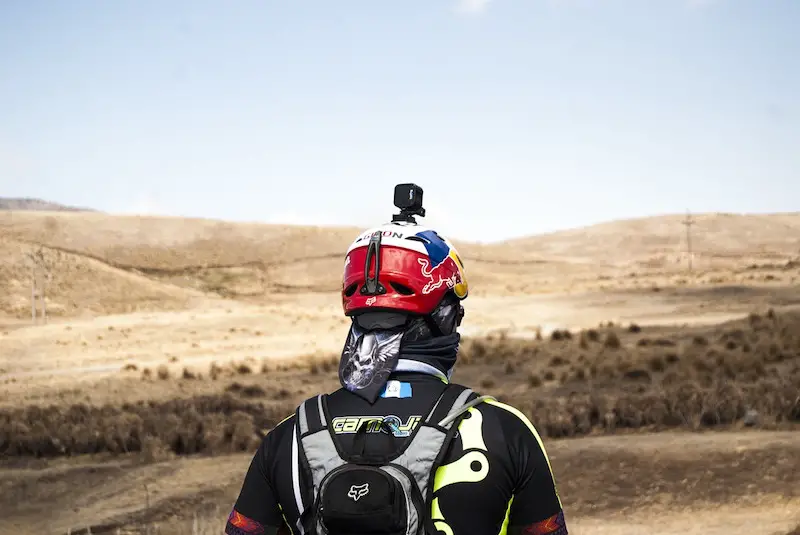
Features to Consider
When looking for the best motorcycle helmet camera for recording your rides, they all come with different features, benefits, and drawbacks.
Here are some of the different features to consider before making your purchase.
Resolution
Personally, the camera resolution is more important than its size. With modern devices a minimum resolution of 1080p is what you should be looking for.
Lower resolutions will look OK on your smartphone, but won’t be as enjoyable to watch on your computer/laptop screen or TV. All of the cameras i’ve recommended have a minimum resolution of at least 1080p.
Depending on what you’re doing with the footage, 4K might be overkill for your needs. However, this is a great resolution for crystal clear images on bigger TVs.
When it comes to photos anything above 8 megapixels is ideal. Photos at this quality will look great on your TV, smartphone, and laptop screen. These can be used for Instagram and other social media platforms.
Size
Most modern motorcycle cameras are small, lightweight, and perfect for mounting to your motorcycle helmet. Avoid going with any cameras that are too big, bulky, or heavy.
Mounting something heavy and bulky to your helmet can affect your balance and posture. It can also result in a less comfortable riding experience.
After mounting the camera, you shouldn’t be able to tell that it’s attached at all.
Mounting Capability
Before settling on any device check that it has the mounting capabilities you need.
For example, the GoPro’s come with a wide range of different mounts. These can be used to attach the camera to your helmet, motorcycle, or anywhere else you want a POV recording of.
The best type of mount is the adhesive mountings that you stick onto a smooth, flat surface. These hold the camera in place while allowing you to adjust the angle to your preferences.
Ease of Use
It’s not easy, and in some places it’s illegal, to operate your camera while riding a motorcycle. You also don’t wan to be fumbling around with the little device as you’re riding along.
Some helmet cams can be operated through wifi or voice controls. These are easy and safe to use when you’re on the bike (though not riding).
With these you can start recording just before you take off. Then, at your destination, you can quickly stop recording. Avoid using your camera while you’re operating the motorcycle.
Capture Settings
Think about what your recording requirements are.
Do you need to capture video in 4K or is 1080p good enough? Is image stabilization important or do you have decent video editing skills?
Decide what you need for recording your rides before settling on a specific camera. This will save you money and make it easier for you to find the right device.
Sound
Sound quality isn’t as important for recording on your motorcycle. The wind noise above 30 miles per hour will drown out your voice and any engine sounds.
Even if you’re interested in moto-vlogging, you’ll have to pick up a dedicated microphone for the best quality sound. For recording rides and taking cool photos this isn’t a requirement.
Screen
Most of the better quality cameras come equipped with a built-in touch screen.
These screens make it easy to access the settings. They also give you the ability to watch your footage when you’re on the road.
Unless you get something smaller like the GoPro Session, most devices will have a screen on the back.
Built-In Storage vs Micro-SD
Running out of storage halfway through a ride isn’t there something you want to experience. Devices that have built-in storage should be avoided.
Instead, look for cameras that record to a micro-SD card. These cards are inexpensive and can be used to record hours of footage.
Battery Life
Rechargeable batteries give you the ability to switch the battery during your ride. When one battery dies you can quickly popping a fresh one to keep recording.
Some cameras, like the Campark ACT74, come with more than one battery. Others, like the GoPro models, only come with one so you’ll have to buy spares.
You can expect between 90 minutes and 2 hours of recording time per battery. Just gives you loads of time to record your favorite scenic routes.
Sharing Capability
Most modern cameras give you the ability to share your video footage and photos wirelessly. This is done either through an app or the device itself.
The wireless sharing capability makes it easy to get your videos and photos online. Then you can quickly upload them to social media or share with your friends and family.
Alternatively, you may have to remove the micro-SD card so it can be plug into your computer. With this method the photos and videos need to be manually uploaded onto your device.
Durability
All of the cameras recommended in this post are durable, well-reviewed, and suitable for recording your motorcycle adventures.
Look for devices that are waterproof and that come with a rugged, durable case. Keeping your devices protected from the elements is important if you’re riding in a range of weather conditions.
The Benefits of Motorcycle Helmet Cameras
Even if you’re not interested in recording your scenic rides, there are other benefits to using a motorcycle helmet camera.
Sharing Your Rides with Other Riders
Just about everybody is using social media these days. Sure, you can tell people about your favorite rides, but wouldn’t it be easier to show them?
With a motorcycle helmet camera you can easily record your best routes and share them on social media. This way all of your riding buddies can enjoy the same places you’re exploring.
Instead of having to write out directions or refer to Google Maps, you can easily share your videos with friends and family online.
Remember Your Experiences
For me personally, i’ve gone on countless rides that i’ve probably already forgotten about. Since I started recording it’s easy to watch old footage and remember all the amazing experiences I’ve had.
Digital cloud storage and physical hard drive storage is less expensive these days. You could go on hundreds of rides and still never fill up a single external hard drive.
It’s always fun to go back and relive those incredible rides.
Safety
If you’re ever involved in an accident having the footage to backup your claims is priceless. You never want to be involved in a scenario where you don’t have evidence of what happened.
Recording your rides can protect you during any altercations on the road. It’s also going to make the insurance process smoother should you be involved in any accidents.
Improve Your Editing Skills
Riders already interested in filmmaking can improve their editing skills by recording their rides. Some people will never do anything with the footage, but others will upload to Youtube.
Instead of uploading the raw footage, video editing can make your rides seem even more interesting and exciting. You can cut out the boring parts and share only the highlights of your riding experiences.
Through creating videos and sharing your experiences it’s only inevitable that your editing skills will slowly improve. You never know – you might one day be able to start making money from motorcycling.
Convenience
It can be annoying to stop and get off your bike just to take a photo of the scenery. With a motorbike helmet camera this is done automatically so you can keep riding.
Before you hop on it’s simple to start recording. After you get back everything you saw will be recorded.
This way you can share the footage you want from the places you visit without having to constantly stop.
Types of Motorcycle Helmet Cameras

Single Unit
These would be the most basic type of motorcycle helmet camera. Single units offer riders only the ability to capture video.
They come with basic recording options and typically shoot in lower aspect ratios. This type would be ideal for riders that want to capture video to playback or edit later.
Integrated
Most of the best motorcycle helmet cameras that we recommended are integrated units. This means they come with an array of different features that can improve the recording experience.
Some of these different features include GPS, 4K resolution, and WiFi capability. Another benefit to integrated cameras is that they can be mounted to various areas, such as onto your motorcycle.
These tend to be bigger than single-unit devices. However, the drawback of size is worth having all of the additional features.
Motorcycle Helmet Camera Pricing
$60 and Under: In this price range you’ll be able to find some high quality motorcycle helmet cameras. These cameras would be equipped with standard video recording features and capable of capturing video in at least 1080p resolution. They also might come with some additional features including various camera angles, GPS, and Wi-Fi.
$60 to $100: In this price range, you’ll be able to find motorcycle helmet cameras with some more functionality. This could include 4K resolution video, touch screen capability, longer-lasting batteries, and wider camera angles.
$100 and Up: In this price range is where you’ll find some of the best motorcycle helmet cameras currently available. These would come with all of the features mentioned above, as well as some additional ones. Cameras in this price range tend to be more streamlined and more robust, ideal for motorcycle riding. They might also come with low-light recording capabilities and some Bluetooth connectivity options.
Other Considerations
Weather
When you’re looking for a helmet camera, think about the weather conditions you’ll be riding in. If you’re riding in the rain or wet weather conditions regularly, you’ll definitely want a waterproof helmet camera.
Battery Life and Batteries
Even the best cameras will only last up to 2 hours of recording time. It will be even less if you’re recording at higher resolutions or turning the camera off and on regularly.
Take a look at the stated battery life for any of the options you’re interested in. Check to see if there are extra batteries available. It’s possible you’ll need more than one battery to make it through your ride.
Best Motorcycle Helmet Camera FAQ
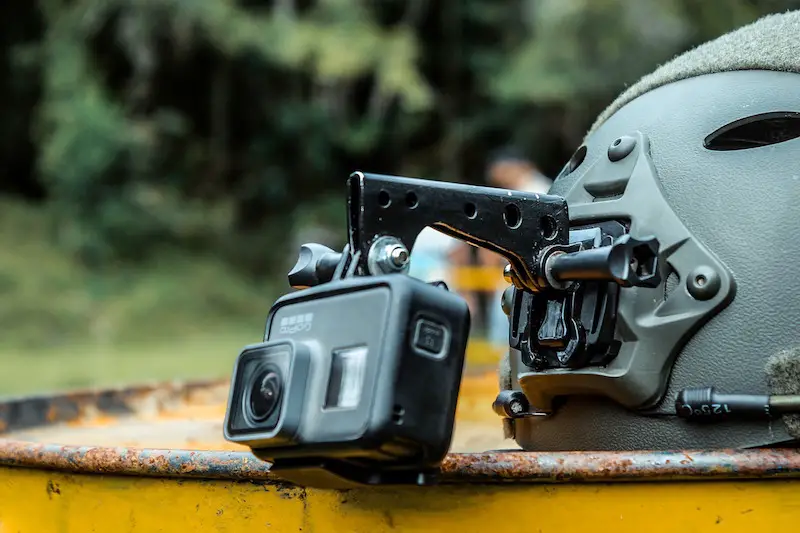
Are Motorcycle Helmet Cameras Legal?
In the United States and Canada you are 100% allowed to mount your camera to your helmet. While some laws prevent you from modifying your motorcycle helmet, attaching a mount isn’t a modification.
Modifications would include drilling holes or removing key components from the helmet that would make it less safe. Attaching a camera using an adhesive mount doesn’t fall under an unsafe modification.
Keep in mind that I am not a lawyer. It’s important for you to research your own local laws and bylaws to determine the legalities behind these cameras.
The best place to start is with a quick Google search. Alternatively, contact your local police or bylaw office with any questions you might have.
How Do You Mount a Motorbike Camera to Your Motorcycle Helmet?
Almost every camera comes with accessories that can be used for mounting it to a variety different surfaces. The most common mount is an adhesive mount, also known as a sticky mount.
These are small, lightweight, plastic pieces with a sticky bottom that you can attach to any smooth surface. After the adhesive sets these mounts tend to stay stuck on their respective surface.
Apart from adhesive mounts, there are also straps and different styles of mounts that can be used. Look online for the different mounts and accessories available from the manufacturer and third parties for the specific type of camera you choose.
How Do You Protect the Camera While it’s Mounted?
Motorcycle helmet cameras can be expensive. It’s important to protect them and prevent them from getting damaged while you’re riding and recording.
To start, make sure you invest in a device that’s durable and well-reviewed. Any helmet-mounted camera you’re interested in should be waterproof to avoid getting damaged in inclement weather.
You’ll also want look for cameras that come with a dedicated protective case, or housing. These cases protect the camera from rocks, branches, and other debris that gets kicked up from the road when you’re riding a motorcycle.
Helpful Tips
- Clean the camera lens before each ride. This results in a clean shot whenever you start recording. Check the lens regularly to make sure it’s not dirty.
- Shoot in a lower resolution. While most cameras can capture 4K video, this resolution isn’t necessary in many cases. It takes up the largest amount of space and drains the battery faster. Capturing in 1080p will get you a longer battery life and more space on your SD card.
- Using the waterproof casing is a good idea to protect your device from rain and other weather elements. However, it’s not going to be protected from a major drop or accident. Consider upgrading to a more durable camera case that will protect the device, especially if you’re riding in rough conditions.
- If you’re recording a lot, consider investing in a larger SD card. With more space, you’ll be able to record more video and take more photos. SD cards aren’t expensive, so it’s worth picking up a bigger one for your camera.









